Speech Recent Financial Developments

Ric Battellino
Deputy Governor
Address to Annual Stockbrokers Conference
Sydney –
- Audio 16.24MB
- PDF version 537KB
Introduction
My talk today is about some of the changes taking place in the financing of the Australian economy.
As you know, after 15 years of rapid growth, credit has been growing at a much more subdued pace over the past couple of years. In fact, for the first time since the early 1990s, banks are finding that credit is growing more slowly than deposits, with the result that they are able to repay funds previously borrowed in wholesale markets, including from offshore. These developments have been associated with a noticeable increase in national saving and a marked reduction in the current account deficit.
I would like to spend some time today going through these developments.
Credit Cycles
Over the very long run, money and credit in most economies tend to grow somewhat faster than GDP. This is part of the financial deepening that occurs as economies develop and incomes grow. Since 1960, for example, credit in Australia has increased on average by about 12½ per cent per year, while GDP (in nominal terms) has increased on average by about 9 per cent per year (Graph 1).
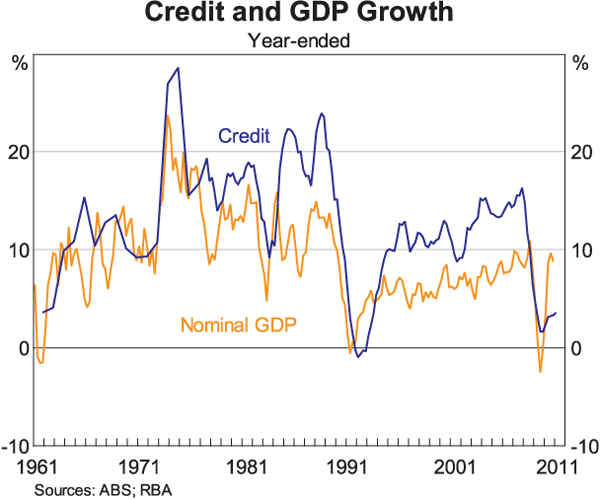
Over shorter periods, however, credit shows pronounced cycles. During periods when optimism is high, households and businesses tend to increase their use of credit, often for the acquisition of assets. At other times, typically in the wake of economic downturns, borrowers can become very conservative and cut back their demand for credit; lenders, too, can become more cautious.
The most recent cycle in credit began in the mid 1990s and extended through the years leading up to the global financial crisis. For most of that period the expansion in credit was driven by households (Graph 2). Financial deregulation and innovation greatly increased the supply of credit, and the fall in interest rates as inflation declined in the early 1990s gave households greater capacity to borrow. The rapid expansion in household debt that followed was not unique to Australia, with most developed economies experiencing sharp rises in household indebtedness. Most of this expansion in household credit, both in Australia and offshore, was used to buy dwellings and was therefore accompanied by strong rises in housing prices.
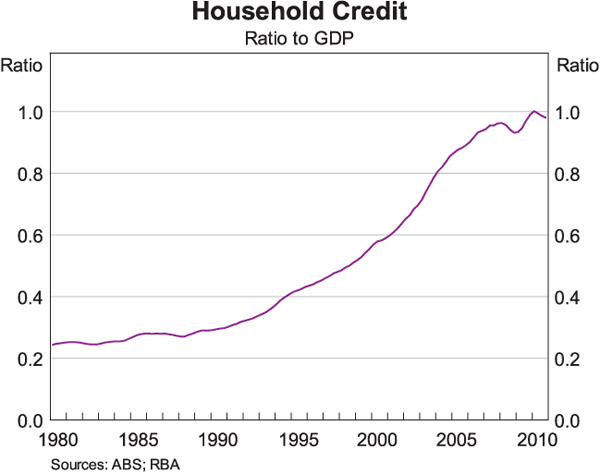
As you know, in many countries the marked expansion in housing credit went on to cause severe financial difficulties. Here in Australia, however, this has not happened; in particular, household loan arrears remain relatively low (Graph 3). Contributing to this better outcome in Australia was the fact that the deterioration in lending standards was not as severe or as widespread as in some other countries. Also, household incomes have continued to grow solidly, in the context of a strong economy and low unemployment.
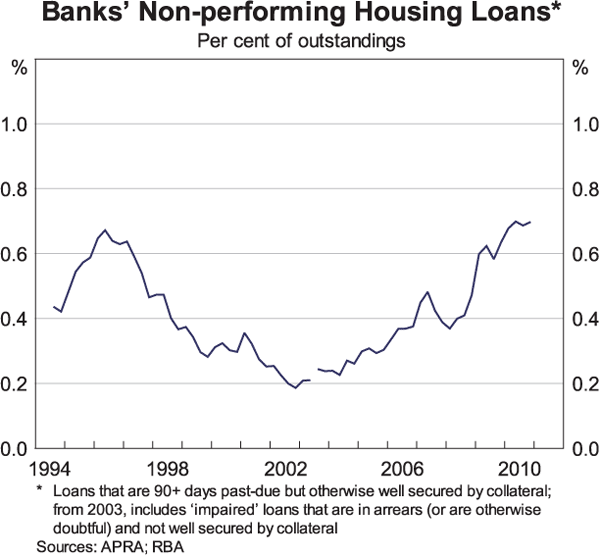
However, within this overall picture of resilience, there are, as always, pockets of housing stress. In the early part of last decade, those pockets were heavily concentrated around the south-west parts of Sydney. These problems followed the very strong rises in Sydney house prices over 2002 and 2003. They were linked to a sharp rise in loan approvals, some lowering of lending standards, particularly by second-tier lenders, and increased speculative activity. Conditions in that region subsequently improved, helped by a period of stable house prices and rising incomes, though the process took a long time and the arrears rate in that part of Sydney remains higher than the national average.
Recently, it has been parts of Queensland and Western Australia that have shown a deterioration in loan arrears, albeit from low levels. As had been the case in Sydney earlier in the decade, the recent increase in loan arrears in these states followed a sharp increase in housing loans and unusually strong rises in house prices between 2006 and 2008. Some part of this was justified by the emerging resources boom but, as had occurred earlier in Sydney, this was accompanied by some lowering of credit standards and increased speculative activity, with the result that some households over-extended themselves. Adding to the stress on household finances was the fact that both these states experienced larger-than-average increases in unemployment during the 2009 downturn, though again from relatively low levels.
Another potential source of vulnerability in the housing market that is often mentioned is the many first-home owners who were attracted into the housing market in 2009 by the increase in the first-home owner grant. The concern is that some of these may have over-committed themselves financially in order to enter the market, and are now vulnerable to rising interest rates. This group bears close watching but, so far at least, first-home owners do not seem to be disproportionately represented in loan arrears.
While the household sector as a whole continues to show a good deal of resilience in meeting loan repayments, the increase in indebtedness over the past 15 years does mean that households are now significantly more sensitive to changes in interest rates. The proportion of household income devoted to debt servicing is relatively high, even though housing interest rates are only a little above average (Graph 4). It is therefore not surprising that households have become more cautious. Household saving increased markedly in the wake of the global financial crisis, and it has remained high in the face of the continuing problems in European financial markets and rising global inflationary pressures (Graph 5).
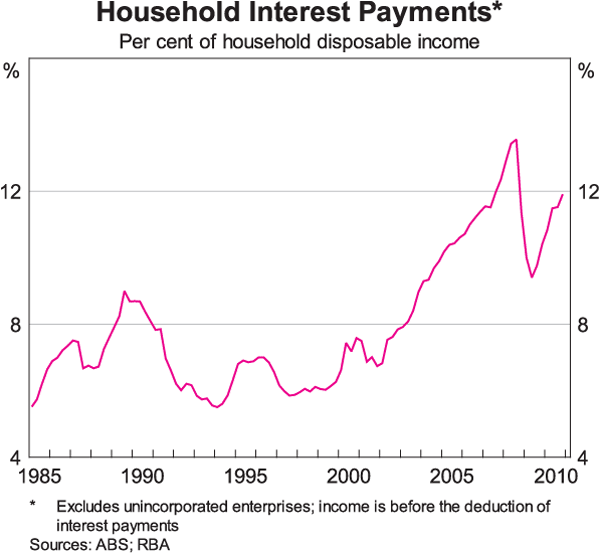
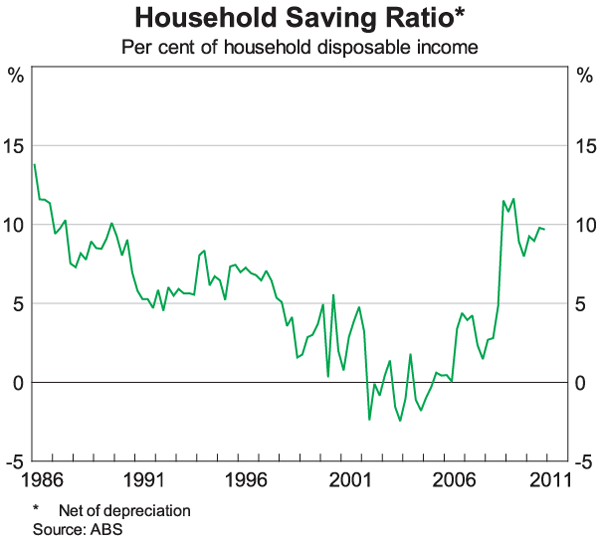
In the current environment, it is unlikely that households will have much enthusiasm for increasing indebtedness. The most likely scenario is that household borrowing will continue to grow at a relatively subdued rate for some time yet. From the Reserve Bank's perspective, this would be a welcome development. It would allow the period of consolidation in household balance sheets to continue and would avoid households adding to pressures in the economy at a time when its productive capacity is already being stretched by the resources boom.
While most of the growth in credit in the lead-up to the global financial crisis was driven by households, a substantial increase in business credit also occurred in the years immediately before the crisis. This expansion in lending was mainly to large businesses and, while some of it was used to fund real investment, a substantial amount was for financial activity.
As often happens during a credit boom, a disproportionate amount of the lending that took place over that period came from second-tier lenders. Business credit provided by foreign banks, for example, rose by about 80 per cent between 2006 and 2008, while business credit provided by regional banks rose by 60 per cent (Graph 6). A lot of this was directed to commercial property.
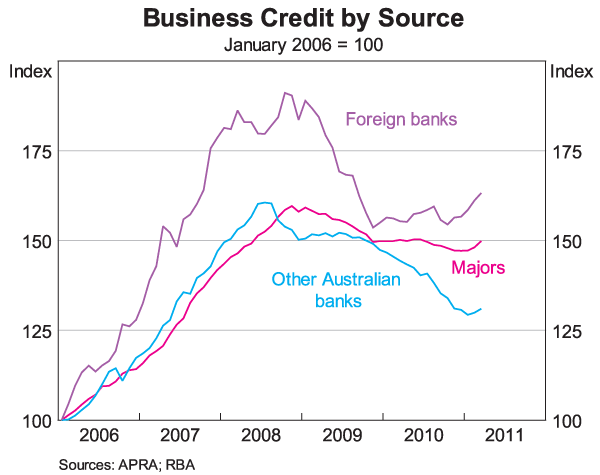
Since the global financial crisis, the inevitable correction has occurred. Business credit has fallen and those lenders that expanded the most have since contracted the most. Similarly, sectors such as commercial property that increased gearing the most have since experienced the sharpest increase in problem loans and the sharpest contraction in credit.
Through all this, credit to the small business sector has been much more stable; it increased by less through the boom and has continued to expand, albeit slowly, since the crisis (Graph 7).
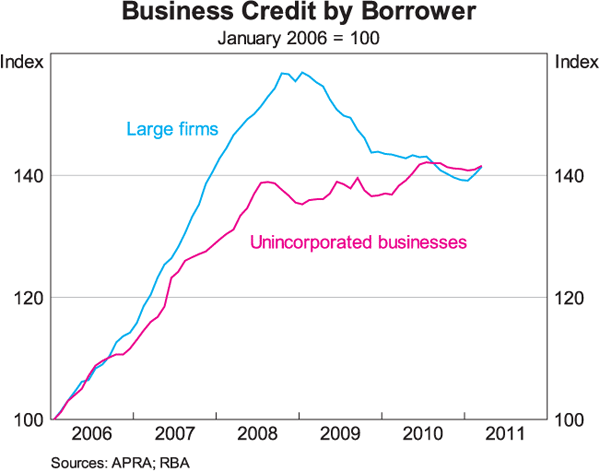
It is not unusual for business credit to be subdued for a time following a period of strong expansion. Both supply and demand usually contribute to this. For instance, businesses often look to repay debt, to repair balance sheets that had become stretched during a boom. Also lenders that expand strongly during a boom often end up making significant amounts of bad loans, and when this becomes apparent they respond by cutting back on new lending.
Normally, periods of soft business credit are accompanied by soft business investment. What is somewhat unusual about the current softness in business credit is that it is occurring at a time when business investment is at a very high level. This unusual conjuncture arises largely from the fact that the strength of investment at present is concentrated in the resources sector, and is being funded mainly by the large amounts of cash that resource companies are generating from existing operations. As a result, despite the very high levels of investment, there has not been the need to resort to substantial borrowing (Graph 8).
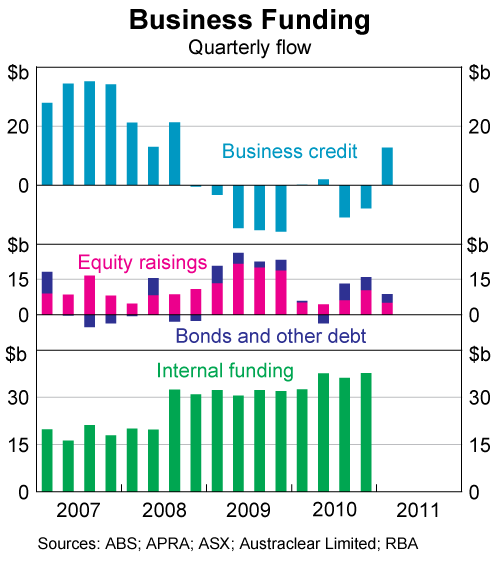
There are signs, however, that the low point in business credit growth is now behind us. Substantial repair has taken place in business balance sheets since the crisis, business investment is picking up and the banking system is showing greater willingness to lend. On average, recent monthly figures for business credit have been somewhat stronger than earlier in the year. It would be normal for this pick-up to continue over the next couple of years as the economic recovery strengthens and broadens.
Implications for Bank Funding
What do recent developments mean for bank funding?
During the period of rapid credit growth that began in the mid 1990s, bank balance sheets expanded rapidly. At the same time, deposit growth slowed noticeably, both because of the decline in national saving and a shift in household saving towards securities rather than deposits. With aggregate credit growing by 12½ per cent per year on average and deposits growing by 10½ per cent per year, banks were left with a noticeable funding gap, which they filled by borrowing in wholesale markets, including from offshore (Graph 9).
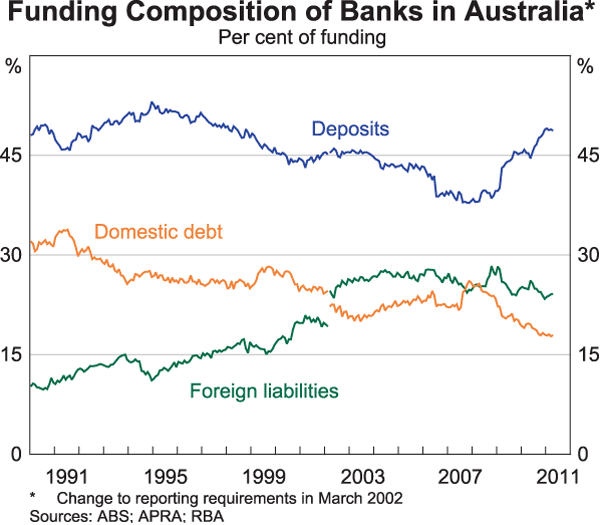
This funding model was well suited to the market conditions of the time. Banks had little difficulty in raising funds in wholesale markets, due to the weight of money seeking investments in Australia. In fact, it could be argued that the whole dynamic was driven by this flow of offshore money wanting to come to Australia – i.e. banks were offered ample amounts of funds by foreigners, which they in turn lent domestically, causing an increase in spending, a reduction in saving, a slowing in deposits and a widening in the current account deficit. This is a situation not dissimilar to that faced by the United States over the past decade, which Federal Reserve Chairman Bernanke has described in detail in his explanation of the global savings glut.
Two things can go wrong in this environment. The first is that the weight of money can lead to an erosion of lending standards as banks try to find more and more borrowers. If this is severe enough, it will eventually lead to a financial crisis because loans are made that cannot be repaid. This is essentially what happened in the United States. As noted earlier, however, here in Australia the reduction in lending standards was relatively slight in comparison.
The second risk, which is the one most people focus on, is that the flow of offshore money suddenly stops. The common presumption is that there would then be a crisis because banks could no longer fund themselves. People who worry about this usually do so as part of a broader concern about countries running current account deficits. This view of the world is not new. Its origins lie in the pre-1970s world of fixed exchange rates, since in that regime a cessation of capital inflow quickly caused a crisis. This framework remains relevant for emerging market economies which have relatively fixed exchange rates and unhedged foreign borrowings, but it is not well-suited for analysing risks in mature economies with well-developed financial markets and a floating exchange rate.
Some people claim that the global financial crisis was a vindication of the view that offshore borrowing causes problems. But this misses the point that all banks were affected by the crisis, irrespective of whether they were borrowers or lenders in international markets. In fact, the Australian banks, which many see as being among the largest users of offshore wholesale markets, emerged from the crisis in better shape than most. While they benefited from a temporary government guarantee, so too did banks in most other countries.
Another point that is often missed in this debate is that, if there is a loss of offshore funding, other things also change due to the ensuing changes in market pricing and consumer and business behaviour. This allows the financial system to adjust. For example, when the financial crisis hit:
- The demand for credit slowed sharply; after growing on average by over 14 per cent per year in the three years to mid 2008, it has grown by only about 4 per cent per year in the three years since.
- Private saving increased, particularly at the household level. This has narrowed the gap between national saving and investment which, as you know, is the counterpart to the current account deficit. The current account deficit in the December quarter fell to 2 per cent of GDP, and is likely to move lower in the immediate future.
- Households became more cautious, shifting their saving from investments in securities towards bank deposits. Deposit growth is currently out-pacing credit growth, allowing banks to reduce wholesale borrowings.
- Capital inflows into Australia did not cease but switched to more conservative investments such as government bonds. The inflow of foreign capital into government bonds during the past year has been more than sufficient to fund the current account deficit, and has been accompanied by the private sector (particularly the banking sector) repaying offshore capital (Graph 10).
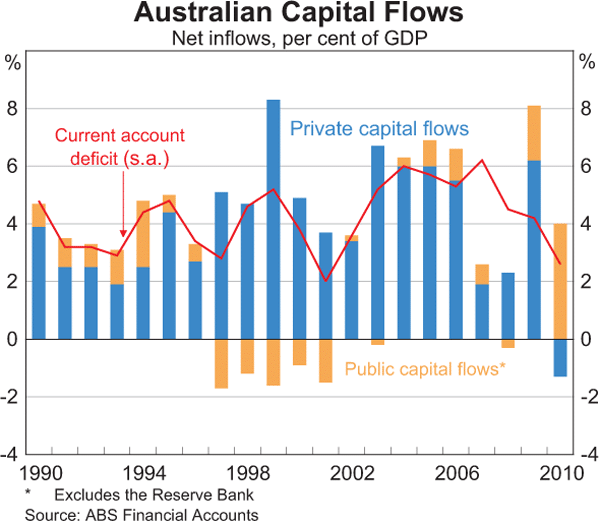
The question that arises is what will happen to bank funding if, as expected, credit growth picks up over the next few years? Will it return to the pre-crisis pattern? This seems unlikely at this stage. For one thing, credit growth is unlikely to return to pre-crisis rates in the foreseeable future so pressures on funding will not be as severe. Second, changes to supervisory rules and market conditions have made pre-crisis funding patterns less attractive. In addition, if household saving continues at its recent higher level, it will sustain deposit growth. The household saving rate could even increase further. It is still below its historical highs and strong employment and income growth could provide the wherewithal for higher saving to co-exist with steady consumption growth. Also relevant will be trends in non-bank capital inflows. If the current diversified pattern of capital inflow continues, this too will add to deposit growth as these inflows find their way into bank deposits. All in all, it is likely that banks will be able to maintain the more conservative funding pattern they have put in place recently.
Conclusion
Let me sum up.
The credit boom that began in the mid 1990s ended with the global financial crisis. The Australian financial system weathered that crisis much better than most and, while the adjustment was not painless, the banking system remained resilient. It is currently transitioning through a period of slower growth.
History tells us that periods of weak credit growth such as the present one are relatively short-lived in a growing economy, so some pick-up in credit growth is to be expected. It would be wrong, however, to think that this means a return to the growth experienced in bank balance sheets in the period since the mid 1990s. That was an extraordinary period, driven by what was largely a one-off adjustment to household gearing following financial deregulation and the sustained fall in inflation. In the economic climate likely to be faced by banks over the next few years – solid economic growth but with cautious behaviour by households and relatively low inflation – it would be reasonable to assume that the rate of growth in credit will remain somewhere in the single-digit range. That rate of credit growth should be able to be matched by deposit growth, reducing the need to raise funds in wholesale markets.